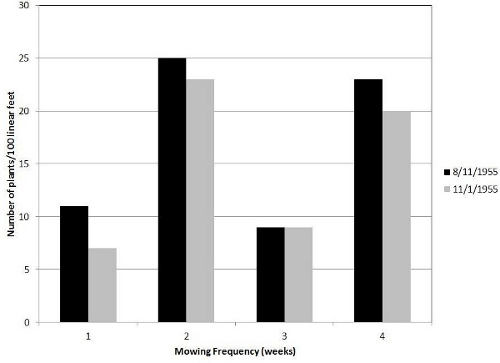- Return to Article Of The Month index
The Impact of Mowing on Smutgrass Control
June, 2011
by Brent Sellers, UF/IFAS, Range Cattle REC, Ona and Jay Ferrell, UF/IFAS, Agronomy Dept., Gainesville
Smutgrass species have been problematic in Florida pastures for the last 60-70 years. It is a perennial bunch-type grass that is capable of producing at least 45,000 seeds per plant. Our work with seed germination shows that seed can germinate nearly year-round, but germination will most likely occur during the rainy season when soil moisture is adequate. Although the hot and rainy conditions of summer is optimum for seed germination, it is common to see smutgrass seedlings in the spring and fall when soil moisture is relatively high. Therefore, prevention of seed production is necessary to limit the amount of smutgrass spread. Preventing seed production, however, is extremely difficult considering that seed heads are produced as early as March in south Florida, and mowing tends to stimulate seed-head production.
Mowing smutgrass, in general, has no long-term effects on eradication. Work performed in the late 1950s at the Range Cattle Research and Education Center revealed that mowing resulted in little change in smutgrass plant density, even when plants were mowed weekly for four weeks (Figure 1). The size of individual clumps decreased by as much as 50%, but the long-term effects of mowing on smutgrass control were negligible and may actually facilitate seed dispersal. The only advantage to mowing smutgrass is that the tender regrowth may be more palatable to cattle.
Prior to the registration of Velpar in 1989, the only herbicide utilized for smutgrass control was dalapon. Research at the Range Cattle REC showed that mowing smutgrass to 2 inches 5 weeks after dalapon application resulted in increased smutgrass control 1 year after treatment. However, dalapon is no longer available and hexazinone (Velpar, Velossa) is the only active ingredient registered that will effectively kill established smutgrass plants. The effect of mowing prior to hexazinone applications has not increased smutgrass control. Research in south Florida also showed that repeated mowing (3 times) prior to hexazinone application resulted in no increase in smutgrass control. Therefore, it appears that mowing prior to hexazinone application will not increase smutgrass control, but rather add more cost to an already expensive herbicide treatment.
Currently, the only viable option for smutgrass control is applying an equivalent rate of 1.0 lb/acre hexazinone (2 qt/A Velpar or 1.67 qt/A Velossa) during the rainy season (July through September). Rain soon after application is essential since hexazinone has relatively no leaf activity and must be absorbed by plant roots. This being the case, no additional surfactant is needed when applying hexazinone It cannot be overstated that the activity of hexazinone is limited by the amount of rainfall received within two weeks after application. If limited rainfall is received, a reduced amount of control should be expected.
Grazing restrictions were once an issue with Velpar; however, the grazing restrictions for beef and dairy cattle have been reduced from 60 to 0 days after application. Haying restrictions are set at 38 days after application. For more detailed information regarding smutgrass control, please see the University of Florida EDIS document entitled “Smutgrass Control in Perennial Grass Pastures" (edis.ifas.ufl.edu/aa261) or contact your local county extension office.
Figure 1. Change in smutgrass density over a three month period following 1, 2, 3, or 4 weekly mowing events. Data adapted from McCaleb et al. (1966) from Florida Agric. Exp. Stn. Circ. S-149.


